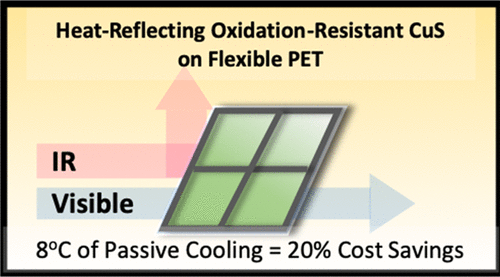当前位置:
X-MOL 学术
›
J. Phys. Chem. C
›
论文详情
Our official English website, www.x-mol.net, welcomes your
feedback! (Note: you will need to create a separate account there.)
Energy-Efficient Stacks—Covellite (CuS) on Polyethylene Terephthalate Film: A Sustainable Solution to Heat Management
The Journal of Physical Chemistry C ( IF 3.3 ) Pub Date : 2020-01-23 , DOI: 10.1021/acs.jpcc.0c00014 Zhen Quan Cavin Ng 1, 2, 3 , Ashutosh Rath 2, 4 , Sing Teng Chua 2, 3 , Shun Okano 5 , Andrew T. S. Wee 1, 3 , Stephen J. Pennycook 2 , Ken Okano 6 , Daniel H. C. Chua 2
The Journal of Physical Chemistry C ( IF 3.3 ) Pub Date : 2020-01-23 , DOI: 10.1021/acs.jpcc.0c00014 Zhen Quan Cavin Ng 1, 2, 3 , Ashutosh Rath 2, 4 , Sing Teng Chua 2, 3 , Shun Okano 5 , Andrew T. S. Wee 1, 3 , Stephen J. Pennycook 2 , Ken Okano 6 , Daniel H. C. Chua 2
Affiliation

|
Regulating the temperature of buildings has the highest expenditure of energy (35–40%); thus, transparent heat reflectors (THRs) have been at the forefront of passive cooling technology due to its ability to reflect near-infrared (NIR) wavelengths without compromising optical transmission. Current designs like metallic thin films and dielectric–metal–dielectric are expensive and face complications with material incompatibility, oxidation, and interdiffusion, which hamper their performance. A cost-effective THR using a single-layer coating has not yet been achieved due to the susceptibility of metals to oxidation. In this work, a layer of CuS was fabricated onto flexible polyethylene terephthalate (PET) via radio frequency magnetron sputtering (RFMS), a high throughput method known for its conformal large-area fabrication. The 150 nm-thick CuS-PET films demonstrated a visible transmission T550 nm of 64.1% and NIR reflectance of 50% that resulted in 8 °C passive cooling. Additionally, wetting the surface resulted in a total of 11 °C of passive cooling due to its hydrophilicity, giving each household an estimated 20% of cost saving per year. Moreover, CuS-PET films are stable in ambient conditions due to instantaneous surface passivation, preventing it from being oxidized and retaining its performance even after three months. Through the optimization of the RFMS fabrication of CuS-PET films, the realization of a cost-effective, single-layer, flexible, and industrially scalable THR is possible.
中文翻译:

节能堆栈—聚对苯二甲酸乙二醇酯薄膜上的Covellite(CuS):一种可持续的热管理解决方案
调节建筑物的温度具有最高的能源消耗(35-40%);因此,透明热反射器(THR)由于能够反射近红外(NIR)波长而不影响光传输,因此一直处于被动冷却技术的最前沿。当前的设计,例如金属薄膜和介电-金属-介电,价格昂贵,并且由于材料不兼容,氧化和相互扩散而面临复杂问题,从而阻碍了它们的性能。由于金属对氧化的敏感性,尚未实现使用单层涂层的具有成本效益的THR。在这项工作中,通过射频磁控溅射(RFMS)在柔性聚对苯二甲酸乙二醇酯(PET)上制造了一层CuS,这是一种高通量方法,以其保形的大面积制造而闻名。550 nm的T为64.1%,NIR反射率为50%,导致8°C的被动冷却。此外,由于其亲水性,润湿表面会导致总共11°C的被动冷却,从而使每个家庭每年节省约20%的成本。此外,由于瞬时的表面钝化,CuS-PET膜在环境条件下稳定,即使在三个月后,它也不会被氧化并保持其性能。通过优化CuS-PET膜的RFMS制造,可以实现具有成本效益的,单层,灵活且工业可扩展的THR。
更新日期:2020-01-23
中文翻译:

节能堆栈—聚对苯二甲酸乙二醇酯薄膜上的Covellite(CuS):一种可持续的热管理解决方案
调节建筑物的温度具有最高的能源消耗(35-40%);因此,透明热反射器(THR)由于能够反射近红外(NIR)波长而不影响光传输,因此一直处于被动冷却技术的最前沿。当前的设计,例如金属薄膜和介电-金属-介电,价格昂贵,并且由于材料不兼容,氧化和相互扩散而面临复杂问题,从而阻碍了它们的性能。由于金属对氧化的敏感性,尚未实现使用单层涂层的具有成本效益的THR。在这项工作中,通过射频磁控溅射(RFMS)在柔性聚对苯二甲酸乙二醇酯(PET)上制造了一层CuS,这是一种高通量方法,以其保形的大面积制造而闻名。550 nm的T为64.1%,NIR反射率为50%,导致8°C的被动冷却。此外,由于其亲水性,润湿表面会导致总共11°C的被动冷却,从而使每个家庭每年节省约20%的成本。此外,由于瞬时的表面钝化,CuS-PET膜在环境条件下稳定,即使在三个月后,它也不会被氧化并保持其性能。通过优化CuS-PET膜的RFMS制造,可以实现具有成本效益的,单层,灵活且工业可扩展的THR。











































 京公网安备 11010802027423号
京公网安备 11010802027423号